McFadden Engineering Integrates Sustainable Infrastructure Design into Vehicle Wash Station
January 27, 2024

Civil engineers are at the forefront of designing sustainable infrastructure solutions that minimize environmental impact while also developing solutions for their clients. Mobile, Alabama-based McFadden Engineering is no exception. The McFadden Engineering team works daily to integrate principles of sustainability into every stage of their projects, from site selection to construction techniques and material choices. By employing innovative design and process practices, the McFadden Engineering team has helped their clients optimize water and wastewater management, reduce energy and water consumption and meet embrace and exceed compliance protocols. Recently, the McFadden team was asked to design a vehicle wash station for a local lumber company.
Problem: Jasper Lumber Company Truck Wash Runoff
Jasper Lumber Company (JLC) desired to construct a vehicle wash for facility personnel to wash and clean equipment, limiting site runoff and distribution of pollutants throughout the facility. The vehicle wash area is intended to collect the wash water runoff and treat it before discharging the water to the sewer connection at the facility. Although there were no effluent requirements from the system, JLC wished to treat the wastewater from the vehicle wash before discharge.
Solution: Filtration System Design with Settling Pit for Vehicle Wash
McFadden Engineering designed a settling or “mud pit” for the collection of solids generated from vehicle washing activities. From this pit, water is drained to pre-treatment/settling tanks with filtration units to further remove suspended solids from the wash water. An oil-water separator for removal of oil and grease before the treated water flowed to an effluent pump station where the treated water was transferred to the sanitary sewer system.
The client was now able to wash their trucks without contaminating their yard, as well as prevent secondary pollutants from impacting the environment via runoff. As a bonus, the effluent from the wash station went through a voluntary pretreatment process, further assisting wastewater Infrastructure.
To learn more about our extensive background in civil and environmental engineering, click the below services to learn more. If you or a member of your organization wishes to hear more about our services, please visit our website or contact us.
McFadden Engineering provided the following services as part of the project:
- Project planning, management, and coordination.
- Performed site visits to gather project information.
- Developed conceptual design of vehicle wash.
- Provided details and specifications of treatment system components.
- Coordination with equipment vendors and assist with procurement of equipment.
- Engineering support during facility construction.
McFadden Engineering’s team of water and wastewater experts specializes in providing environmentally sound solutions to solve unique civil and environmental engineering needs. Based in Mobile, Ala. for more than 30 years, McFadden Engineering has worked on projects including environmental permitting for municipal, commercial and industrial dischargers, site assessments and remediation, master planning for utilities, water quality projects and wastewater process design. Visit mcfaddenengineering.com for more information.
Three Ways to Implement Office Eco-Friendliness
December 15, 2023
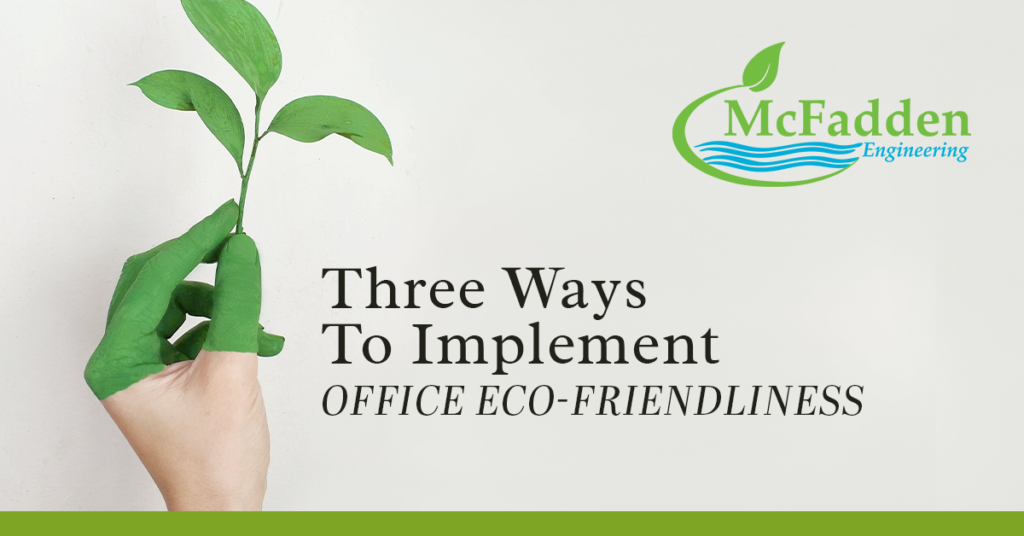
In an environmentally conscious world, businesses are increasingly seeking sustainable solutions for their operations. Whether the office is large or small, we have seen a significant increase in businesses making an extra effort to be more eco-friendly. McFadden Engineering would like to suggest practices that can easily be implemented by your business to reduce negative environmental impacts and decrease your organizations environmental footprint.
Transition to LED lighting
Light-emitting diodes, otherwise known as LED lights, are commonly considered the most energy efficient and quality lights available. In fact, the Department of Energy states that LED lights use at least 75% less energy than incandescent lights, with a lifespan of up to 25 times longer. Not only do they last significantly longer, making them a cost-effective alternative, but they only produce 20% of their energy as heat. By not emitting more heat than necessary, LED lights can maximize energy efficiency at a cost-effective price. By switching your office to LED lighting, you can reduce your budget and experience much more efficient lighting.
Invest in a Smart Thermostat
Smart thermostats have been on the market for more than 10 years and continue to improve in both energy savings and cost efficiency. Thermostats are deemed “smart” if they connect to wireless internet allowing the user to remotely make changes in the operational settings. These thermostats also allow for the use of implementing programming and quickly and easily making system adjustments. The most important feature to identify when shopping for a smart thermostat is the “ENERGY STAR” criteria, ensuring that the product meets strict energy efficient criteria set by the U.S. Environmental Protection Agency (EPA) or the U.S. Department of Energy. Data gathered by the E.P.A. shows that thermostats that meet this particular criteria save users an average of 8% on their utility bills.
Additionally, smart thermostats consume significantly less energy by simply turning off the heat or air conditioning on a more regular basis than normal thermostats. Smart thermostats can function without sacrificing comfort by adjusting the temperatures when nobody is using the office space. This energy-saving mode is automatic in many thermostats, however, other capabilities like customizable schedules allow for more user control of your offices’ overall energy savings.
Make the Push to Paperless
While going completely paperless is an incredibly challenging undertaking and can take and the commitment from team members to properly complete, making the effort to greatly reduce paper usage in the office can be an achievable goal. This reduction can reduce your operating costs, increase your business’s competitiveness in the market, and greatly reduce waste as well. By implementing and incentivizing the transition from paper usage to digital solutions, such as moving all communications to email rather than print or mail correspondence, you can embrace new technology, as well as support sustainability goals. According to Forbes, approximately 26% of waste dumped in American landfills is discarded paper. To make matters worse, rotting paper is a source of methane gas, which the U.S. EPA reports is more than 28 times as potent as carbon dioxide at trapping heat in the environment.
From a financial standpoint, according to Corp! Magazine, businesses in the United States waste up to $8 billion on paper management per year. Your business can take small steps by implementing paperless software that will reduce costs and cut your carbon footprint.
Businesses making efforts to embrace eco-friendliness is no longer a rarity and is becoming an expectation by company leadership and employees. For organizations to be at the forefront of their industries, both large and small, steps must be taken to reduce their carbon footprint and show their desire to be more environmentally friendly.
If you’re interested in learning more about what your business or you as an individual employee can do to support office sustainability, read our blog about workplace recycling for additional steps you can take to be eco-friendly.
McFadden Engineering’s team of water and wastewater experts specializes in providing environmentally sound solutions to solve unique civil and environmental engineering needs. Based in Mobile, Ala. for more than 30 years, McFadden Engineering has worked on projects including environmental permitting for municipal, commercial and industrial dischargers, site assessments and remediation, master planning for utilities, water quality projects and wastewater process design. Visit mcfaddenengineering.com for more information.
McFadden Engineering Celebrates America Recycles Day
November 11, 2023
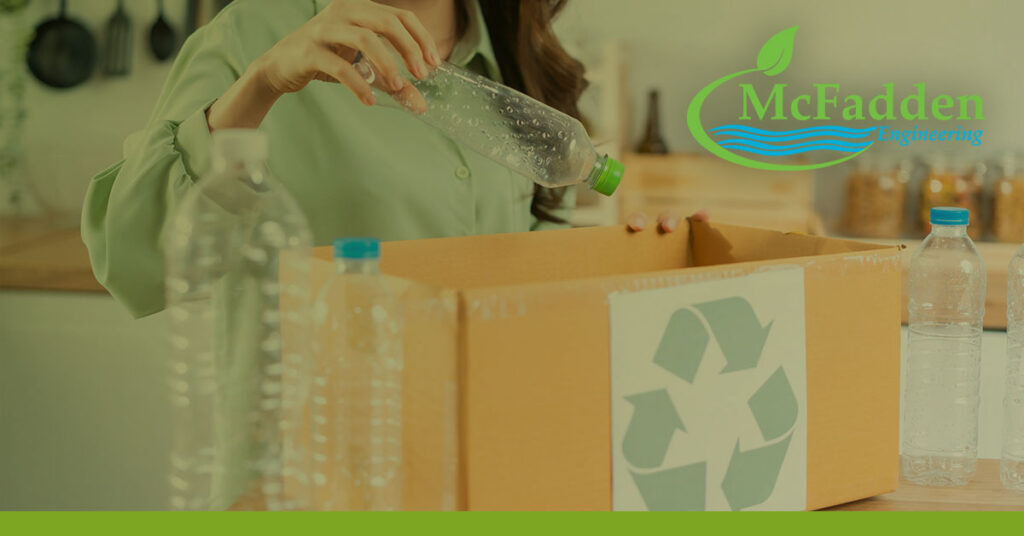
Held annually on November 15, America Recycles Day is a nationally recognized day devoted to the promotion of recycling, the purchasing of recycled products and the reuse of non-disposable items. More specifically, America Recycles Day focuses on the actions of the individual and highlights the changes that any individual can make for the betterment of the environment. At McFadden Engineering, our core values of sustainability and environmental conservation display our conviction for environmental protection and improvement. With more organizations embracing green initiatives and implementing more corporate social responsibility policies, it is becoming clear that being environmentally responsible is more than just a trend. This blog will look at the efforts both organizations and their employees can make to reduce waste in the workplace.
Setting up a water station
The Container Recycling Institute states that each day in the United States, more than 60 million plastic water bottles are thrown away. Help lower this number by adding a water station to the workplace. Water stations encourage employees to ditch their single-use plastic water bottles and incentivize the use of reusable thermoses and bottles. Water stations not only cut back on waste but save both the employee and organization money on water expenses.
Recycling Ink Cartridges
According to the Energy Collective Group, more than one million ink cartridges are thrown away in the U.S. per day. Additionally, the Energy Collective Group adds that it takes 1,000 years for a print cartridge to fully decompose in a landfill site. These cartridges contain volatile organic compounds and heavy metals that pollute the soil and water upon their arrival at landfills. An easy way to help prevent this pollution is by dropping off your used cartridges at your local office supply store. Another helpful tip is to check the Earth911 website, which provides a comprehensive list of recycling locations in your area.
Switch to a coffee maker
While most offices have coffee makers, often, the makers rely on plastic pods to brew the coffee. Switching to a bean-to-cup or reusable filter machine not only provides a fresher and more authentic taste but greatly reduces plastic waste as well. However, if pod machines are the overwhelming popular choice amongst employees, be sure to look for recyclable pod brands. These recyclable pods can be found in both plastic and aluminum, meaning that you can keep the familiarity and convenience of pods without sacrificing your environmental responsibility.
What can employees do?
Now that we’ve examined ways organizations can promote recycling and sustainability in the office, let’s look at some ways individual employees can help promote recycling and environmental conservation in the workplace.
Bringing in a wasteless lunch
In a report published by Design Life-Cycle regarding single-use plastic bags, the organization reports that the average U.S. family uses 500 of these bags a year. These bags are not biodegradable and have been consistently linked to creating a hazardous environment for both land and aquatic life. While it is important to encourage the proper disposal of these bags, packing a lunch in reusable containers is much more conservation-friendly. The single-use nature of plastic bags promotes more litter with lunch, but this can be completely avoided by packing your meal in a multi-use container. By reusing containers, individuals can greatly reduce their amount of daily waste.
Properly recycle electronics
As workplace technology continues to improve, knowing what to do with unwanted or out-of-date electronics has become a modern problem for many employees. The official term for this kind of material is e-waste and includes items like cell phones, computers, batteries, CDs and other electronics that come to mind. As previously mentioned, the website Earth911 offers a list of locations in your area designated for specific types of recycling, including e-waste. The World Counts estimates that e-waste comprises 70% of our overall toxic waste with only 12.5% of e-waste being recycled. The importance of properly recycling e-waste cannot be understated, even at the individual level.
Properly dispose of your emails
Shockingly enough, emails are responsible for a large amount of CO2 emissions. Email and data centers that store your virtual files use a lot of energy and electricity to run. In fact, Science Focus magazine states that emails are responsible for as much CO2 globally as seven million extra cars. Cleaning out your inbox from old emails and digital files can save space and energy on both your computer and email/data centers.
The purpose of America Recycles Day is to encourage and urge people to reduce, reuse, repurpose and recycle in every aspect of their life. This includes keeping an environmental preservation mindset not just at home, but in the workplace as well. While companies can encourage their employees to do everything they can to reduce waste, the power to make change lies with the individual. America Recycles Day highlights the actions of the individual and the changes that they can make for the betterment of the environment. There are many ways for both companies and their employees to promote sustainability, from properly recycling e-waste to cleaning out your email inbox.
At McFadden Engineering, we pride ourselves on staying environmentally vigilant however we can. From offering environmentally sound solutions for unique engineering needs, to celebrating America Recycles Day, we are proud to be at the forefront of environmental conservation.
Visit our website to see what McFadden Engineering can do for your business.
McFadden Engineering Celebrates Campus Sustainability Month
October 20, 2023

Celebrating Campus Sustainability Month
Throughout the month of October, McFadden Engineering celebrates Campus Sustainability Month as recognized by the Association for the Advancement of Sustainability in Higher Education. Campuses around the United States engage students in sustainability efforts such as incentivizing bike rentals, recycling and more. While these displays of environmental conservation are meaningful and worthwhile, a lot more goes on behind the scenes at university campuses and educational institutions to maintain sustainability goals. This week, we are speaking with McFadden Engineering Firm Partner, Brad Newton, to find out how McFadden Engineering supports campus sustainability.
Q: Does McFadden Engineering have experience working with universities?
A: The University of Mobile is an institution of just under 2,000 students and a 20-minute drive away from McFadden’s office. We provide weekly operational services to their onsite fixed activated sludge package plant years after its design and build. This treatment system is the primary treatment option for the entire campus’s wastewater.
Q: How does this wastewater treatment project promote campus sustainability?
A: The application of this fixed activated sludge package plant is to take wastewater generated by the university, treat it and inject it back into the ground to recharge the natural aquifer. The water being used to recharge the aquifer (a naturally occurring body of rock or sediment that holds water in the ground) is treated, meaning that although it is not used for drinking purposes, it meets the standards of drinking water. Instead of drinking water, the water in this specific aquifer is utilized by the on-campus sprinkler systems. The university wide sprinkler systems are used in various applications, watering landscape areas, soccer fields and other sports facilities. It is a sustainability project in that the water is being kept on-site and sustaining that resource on campus. Our goal was not only to reduce costs but to reuse the university’s treated wastewater on campus for multiple applications. Looking at optimizing water usage and water resources on campus is something that we do for a lot of customers. In addition to recharging the natural aquifer, there is no longer a direct discharge to Chickasaw Creek therefore eliminating any potential health risks and significantly improving the university’s environmental compliance.
Q: What sustainability efforts has McFadden Engineering employed to assist high schools and primary schools?
A: The goal of Campus Sustainability Month is to raise visibility and awareness of sustainability. Supporting sustainability at a grassroots level in education, especially in the local community, is something that McFadden Engineering has always strived for. We have three clients that we service in the community. Some of them do not have access to a municipal sewer system, so on-site systems are their only option. You must get creative when addressing these schools’ specific issues. One project at Leroy High in Washington County, Alabama was completed after we designed a membrane bioreactor treatment facility that replaced the school’s fixed activated sludge treatment plant and chlorine addition system. The system was designed to be as efficient as possible, while still being reasonably priced. We are still assisting Leroy High with ongoing permit compliance and any process-related issues with the treatment system.
Q: What services can McFadden Engineering provide to other campuses/learning institutions to promote sustainability and environmental compliance?
A: Despite water scarcity not being as prevalent in the Southeast as in other areas of the country, we know that water conservation is something to be taken seriously. According to the United States Environmental Protection Agency, 40 out of 50 state water managers expect water shortages under average conditions in some portion of their states over the next decade. Performing water optimization analysis and water reuse studies regarding equipment and usage in different areas of campus to see if there are any opportunities for water conservancy is just part of what we offer. Our goal is to offer water resource projects for landscaping, aquifer recharge or whatever the situation may require reducing overall cost and consumption. Educational budgets can be tight, especially at the university level. It doesn’t have to mean spending more money to increase sustainability. Simple suggestions, alterations and evaluations can help make an organization’s processes more efficient. Part of the sustainability aspect can come from plant operation modifications; it does not always mean purchasing a new system.
The Intricacies of Campus Sustainability
While the extreme importance of previously mentioned surface level sustainability projects like recycling and bicycling cannot be understated, it’s important to remember that much more goes into sustainability behind the scenes. By providing these wastewater treatment services, McFadden Engineering has been able to assist the University of Mobile and multiple other learning institutions in the surrounding areas to reach their sustainability goals and lower their operating costs by doing so.
To learn more about McFadden Engineering’s work with the University of Mobile, read our case study and system overview. To learn more about the role Brad Newton serves, read his bio.
McFadden Engineering Can Help Your Organization Achieve ESG and Sustainability Goals
September 24, 2023
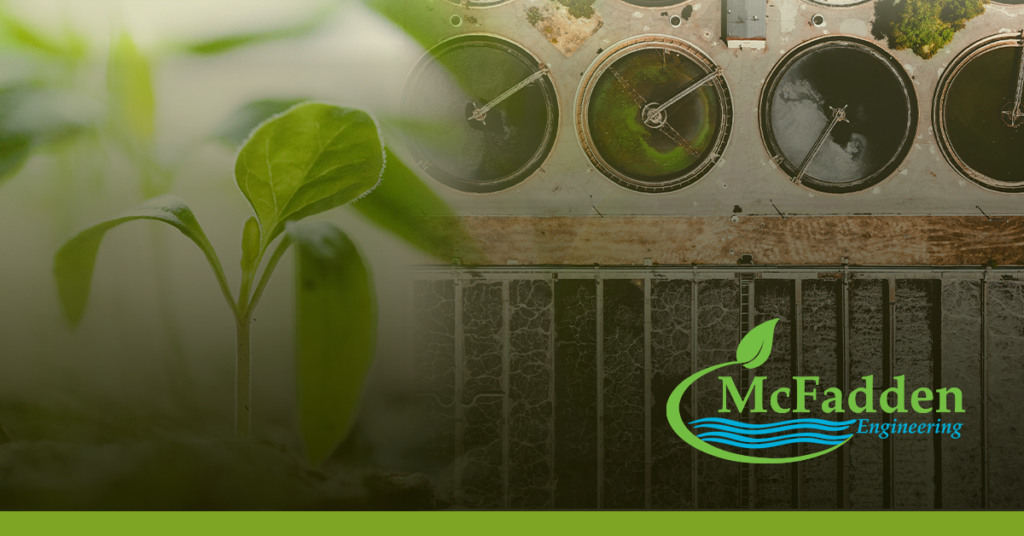
McFadden Engineering and ESG Strategies
For 30 successful years, McFadden Engineering has worked with clients to look beyond the standard profit/loss margins of their company and incorporate engineering and environmental concepts such as sustainability and corporate social responsibility. It is embedded within McFadden’s core values to ensure and prioritize environmental responsibility. The three pillars of ESG are environmental, social and governance-related strategies. Embracing these pillars can help your organization become more self-sustainable and environmentally focused. McFadden Engineering can help your organization implement its ESG strategies and achieve its sustainability goals.
Environmental Practices
McFadden Engineering offers comprehensive environmental engineering solutions designed to safeguard the environment from the consequences of both natural phenomena and human actions. Our extensive background in environmental engineering encompasses the creation of optimal facility compliance protocols, the formulation of spill and response plans tailored for industrial clients and the assessment of treatment options to meet authorized discharge limits. Additionally, McFadden maintains strong ties with regulatory agencies at the local, state and federal levels. This allows our engineering team to successfully guide our clients through the environmental permitting process, saving both time and resources. Finally, our compliance audits help clients fulfill their legal environmental obligations and social responsibility goals.
Social and Governance Practices
Both the social and governance practices in ESG strategies are related to how a company functions overall. Internal management strategies, of universities and food processors have trusted McFadden Engineering to assist them. Our experienced engineering team and skilled Class 4 Wastewater Operators provide comprehensive services for small to medium-flow wastewater systems. We offer maintenance, training and full facility management. Whether it’s assessing and maintaining existing wastewater treatment operations, addressing recurring operational challenges or enhancing overall plant efficiency through process optimization and technology integration, we have you covered.
What is the Purpose?
Implementation of ESG strategies is often viewed as a cumbersome process, and it can be easy to lose sight of the incentives of implementing these strategies. While responsible and ethical practices become more normalized with the continuous employment of these exercises, let’s look at some other benefits of ESG strategies.
- Strengthen Financial Performance – With the reduction of energy spending, operating costs and other expenses, organizations can calculate the ROI of their investment in ESG strategies.
- Strengthen Brand Image – A successful ESG program can make your company more attractive to potential customers, investors and employees. In fact, Retail Info Systems News states that 80% of customers are more likely to buy from an environmentally sound company, while 76% of consumers say they will stop buying from companies with poor environmental and employee treatment.
- Employee Productivity Spike – A noted side effect when implementing strong ESG strategies is the attraction of quality employee applications and interest. Employee motivation is enhanced due to a sense of purpose. Increased productivity in existing employees is commonly seen as well.
Our Commitment to ESG Strategies
McFadden Engineering’s commitment to integrating ESG strategies into our business model not only reflects our dedication to responsible corporate practices but also offers a multitude of benefits for organizations considering a similar approach. By embracing ESG principles, organizations can strengthen their financial performance, enhance their brand image and normalize everyday ethical environmental and business practices. McFadden Engineering prides itself on helping organizations looking to create a more sustainable, socially responsible and financially prosperous future.
To learn more about our extensive background in environmental engineering, check out some of our related project work. If you or a member of your organization wishes to hear more about our services, please visit our website or contact us.
World Water Week: Celebrating Our Most Precious Natural ResourceEnvironmental Feasibility Studies by McFadden Engineering
August 22, 2023
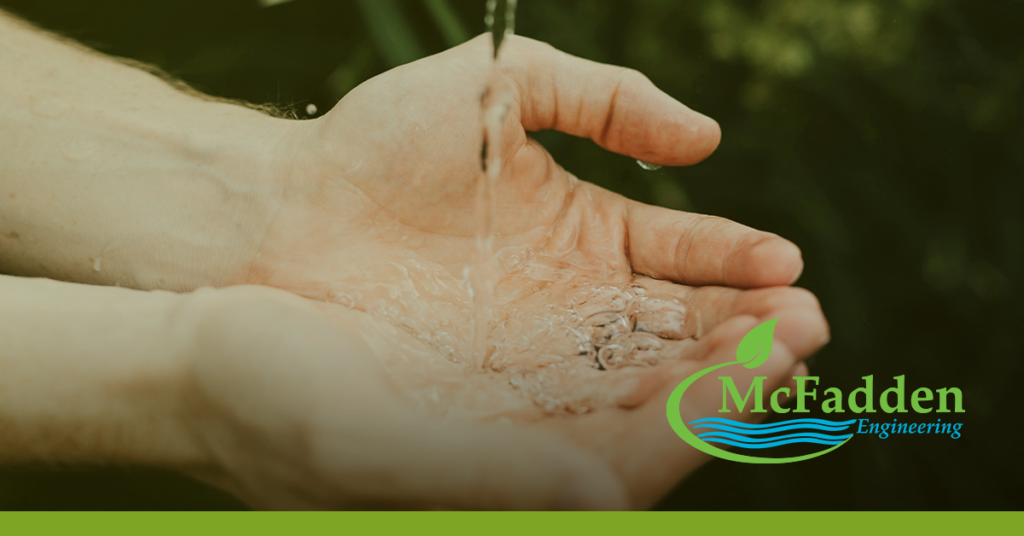
Celebrating Our Most Precious Natural Resource – Water
World Water Week coincides with National Water Quality Month, both of which seek to raise awareness about this natural resource that impacts every business and citizen daily. McFadden Engineering works with our clients to not only meet the requirements of federal, state, county and municipal regulations but also design and engineer solutions that enable them to be good stewards of this natural resource.
Did you know?
The United States Geological Survey (USGS) reports only 2.5% of Earth’s water is freshwater. Of this freshwater, almost all of it is locked up in ice and in the ground. Only a little more than 1.2% of all freshwaters are surface water, which serves most of life’s needs. Most of this water is locked up in ice, and another 20.9% is found in lakes. Rivers make up 0.49% of surface freshwater. Although rivers account for only a small amount of freshwater, this is where humans receive a large portion of their water.
Due to the life cycle of water, the chances of water impacted by McFadden Engineering clients returning to surface freshwater is significant and therefore becomes a priority to return water that meets the necessary compliance protocols.
World Water Week
Many of the world’s greatest challenges are inextricably linked to water, its use and management. World Water Week 2023 is focused on innovation at a time of unprecedented challenges. The theme Seeds of Change: Innovative Solutions for a Water-Wise World invites everyone to rethink how they manage water, as well as consider ideas, innovations and governance systems needed for a more unstable and water-scarce world.
National Water Quality Month
Celebrated each August and created by the Environmental Protection Agency, this month seeks to remind everyone of the challenges facing water. The U.S. government has taken steps to protect this natural resource.
Recap of Water Legislation
- 1948 – The Federal Water Pollution Control Act of 1948 was the first major U.S. law to address water pollution
- 1972 – Clean Water Act passed by Congress
- 1974 – Safe Drinking Water Act passed by Congress
- 2005 – National Water Quality Month was founded by the Environmental Protection Agency (EPA) and backed by the United Nations
The McFadden Engineering team partners with your business to not only identify and solve water and wastewater-related issues but educate our clients regarding best practices. We offer the following services:
Water Quality and Hydraulic Modeling
Environmental Engineering Services
Water and Wastewater Treatment
Industrial Wastewater Treatment
Contact McFadden Engineering and our team of professional engineers and geologists to evaluate and solve your civil and environmental engineering issues. Learn more about our breadth of engineering services and contact us for more information.
Environmental Feasibility Studies by McFadden Engineering
July 28, 2023

A feasibility study is an analysis of the likelihood of a project being successful. The “success” of the project is primarily dependent on ROI and whether the return is high enough for a project to be considered worthwhile. While a good return is seemingly the benchmark for a successful study, there are multiple factors for completing a feasibility study, including environmental regulations, impacts and possible repercussions. This month’s blog focuses on the steps needed to conduct a successful environmental feasibility, and how McFadden can conduct your company’s next environmental feasibility study.
Step One: Identify Regulatory Aspects of Project
Step one involves the identification of all regulatory aspects relevant for obtaining the needed environmental approvals. This requires an analysis of the project location and application as well as federal, state, county and local regulatory components. The following are questions that must be answered prior to step two.
- What are the stages for environmental approval?
- What is the level of detail and time required in each of those stages?
- What is the scope of the environmental assessment needed for the project stage approvals?
- How long will the regulatory process take, considering the overall project scope?
Step Two: Identify Environmental Impacts of Project
Step two involves thorough due diligence to identify, describe and quantify the environmental impacts of the project. McFadden Engineering offers expertise in the following services making the impact analysis a digestible process for your company.
- Environmental Compliance
- Environmental Engineering
- Site assessment and Remediation
- Water Quality and Hydraulic Modeling
An analysis of the project’s environmental impact on the area including direct and secondary impacts, immediate or long-term effects and temporary or permanent consequences is necessary for a comprehensive impact analysis.
Step Three: Develop Strategy to Mitigate Impacts and Overview of Project Environmental Plan
Step three involves development of a strategy to mitigate project environmental impacts including the development of plans to minimize the most significant environmental effects. These include feedback of project technical requirements to alter aspects of the design and determine if modifications can reduce environmental costs. As well as a cost assessment of the necessary items identified in steps one and two to calculate overall project environmental ROI.
At McFadden Engineering, our team of talented engineers and geologists have more than a century of combined civil and environmental experience. Our company is a combination of engineering and environmental experts working together to generate environmentally sound solutions to water, wastewater and civil engineering problems. To learn more about our work, contact us at 251-470-6870.
Five Tips for Developing a Safety-First Mindset
June 27, 2023
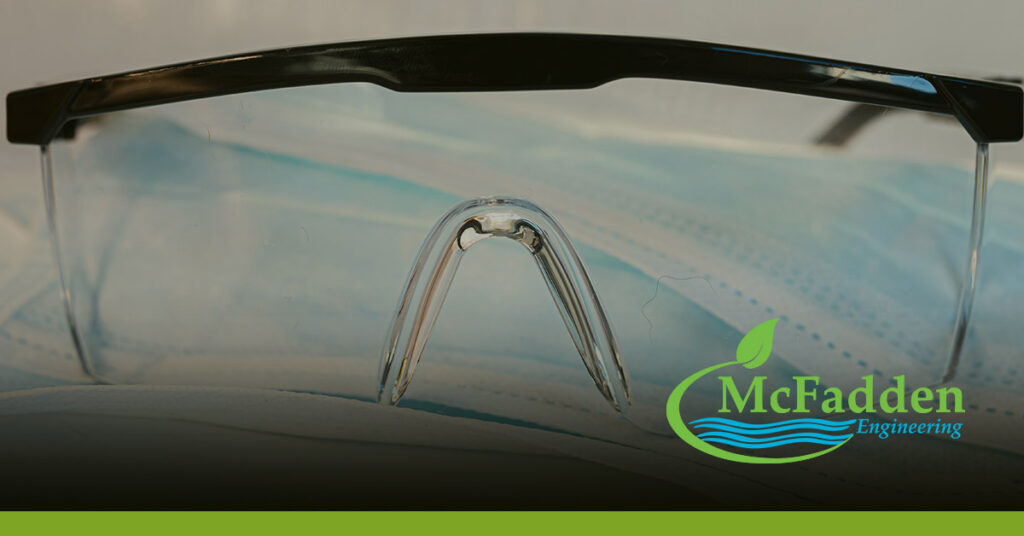
With a wide range of expertise throughout various sectors of the engineering industry, McFadden Engineering boasts experience in a variety of service areas. From involvement in facility management to wastewater treatment process evaluation and design, McFadden Engineering is familiar with wastewater treatment plants and the operation of those facilities. No matter the plant setup or the job within the plant, one thing remains constant throughout the industry. Developing and maintaining a “safety-first” mindset while on the job is the most important tool our engineers try to impart to our clients.
Having a safety-first mindset means being aware of your surroundings. When working in an municipal or industrial wastewater treatment facility, it is important to remember you are working with equipment and chemicals that can be dangerous if not operated safely and correctly. It is important to keep this mindset to ensure your own safety as well as the safety of others in the workplace. With more than 5,000 fatal work injuries occurring in 2021, it is important to create a safety-first environment. Here are a few ways that McFadden employees implement safety in every project that we perform.
Wear Personal Protective Equipment (PPE)
Wearing safety equipment means protecting yourself and those around you. Personal Protective Equipment (PPE) is equipment worn to minimize exposure to hazards that cause serious workplace injuries and illnesses. Personal protective equipment may include items such as gloves, safety glasses and shoes, earplugs or muffs, hard hats, respirators, or coveralls, vests and full body suits. Employers should also train each worker required to use PPE so that they know when it is necessary, what kind of PPE is necessary, how to properly use the PPE, the limitations of the PPE and the proper care, maintenance, useful life and disposal of the equipment.
This equipment is used to help prevent injuries and illnesses that may result from contact with chemical, radiological, physical, electrical, mechanical or other workplace hazards. Occupational Safety and Health Administration (OSHA) standards require specific PPE be used in certain settings (i.e. general industry, maritime, construction, etc.)
Use of the Proper Equipment and Machines
One of the most common ways injuries unfold in an industrial work environment is through contact with machines. In 2020, there were more than 195,000 nonfatal injuries involving contact with objects and equipment. It can be easy to fall into a dangerous, yet convenient routine when operating equipment. Remaining vigilant and being aware of proper operating procedures while working with machines could be the difference between injury and safety.
Knowing Your Workplace
Being prepared for unpredictable situations is one of the most important things you can do in the workplace. It is critical to know the locations of the nearest emergency exit, eye wash stations and other designated areas that prevent or aid in emergency situations. In the event of an emergency, know who to immediately inform, where they are located and the muster point of your facility.
Be Aware of Your Surroundings
Being aware of your surroundings is key to any workplace, especially in an industrial facility. This can involve anything from remembering to take breaks after long periods of work or using drip pans and guards when dealing with potentially hazardous liquids. Awareness also includes keeping your work area clean, keeping exits and walkways unobstructed and keeping your equipment organized and in the proper storage area. While some things may seem redundant and silly, remaining conscious and mindful of the little things can help make your job easier and keep you and your coworkers safe.
Be a Team Player
Being a team player means looking out for the safety of others in your workplace. This does not always require brave heroics but can be as simple as speaking up to supervisors about unsafe conditions. Although it may not seem like much, preventing falls in any form is a huge service, with more than 210,000 workers missing time in 2020 alone from fall-related injuries. Good communication with your coworkers is also important especially when working in a dangerous environment.
A certain threat or risk is innate and expected when working in an industrial environment. McFadden Engineering is committed to creating the safest workplace possible. By developing and maintaining a safety-first mindset and utilizing these tips, you can help make your work environment safer.
For more information about McFadden Engineering’s Facility Management and Operations services, click here or contact our team.
Water and Wastewater Process Consulting: Enhance Your Wastewater Treatment Plant’s Efficiency with On-Site Engineering Consultants
May 26, 2023

As a manufacturer or someone that occupies a space in the industrial sector, your process will likely create byproducts. In many cases, these are water or wastewater that will be regulated on a local, state or federal level. At McFadden Engineering, we realize that achieving environmental compliance can be challenging with your expertise focused on other areas of your organization. McFadden Engineering excels in providing a streamlined process through safe, cost-effective and innovative solutions while helping your organization achieve compliance.
Wastewater treatment plants include numerous individual treatment processes within the overall treatment train. Each of these individual processes has optimum operating conditions that allow them to efficiently handle the specific parameters which the process is designed to treat. The misalignment of one of these parameters can result in a treatment process that is costly and difficult to maintain. In a worst-case scenario, your wastewater process can fail completely and potentially lead to environmental compliance issues and poor effluent water quality.
At McFadden Engineering, we offer consulting services to your organization providing the ability to conduct an analysis and review your current process, access equipment and implement process optimization.
Process Optimization
The first part of wastewater treatment process optimization includes a thorough evaluation of the process parameters that affect your wastewater treatment process. During this evaluation, our team of engineers and wastewater operators will assess lab data to detect how the plant is treating the wastewater. Additional testing and analysis can be conducted to evaluate the performance of the individual processes in the wastewater treatment facility. After we complete a thorough evaluation of your current process parameters, we can conduct an equipment analysis and test other components of your plant’s process.
Equipment Operation Analysis
A typical approach to equipment review involves three main objectives: conducting an equipment audit, identifying equipment issues and developing a plan to address the identified equipment faults. When equipment is evaluated by our team, we most often look at the yearly maintenance schedule to determine if the equipment is operating at its optimum level. An equipment audit review is an integral part of any organization’s wastewater treatment plan. Our equipment review findings can give us a glimpse into your plant’s wastewater treatment facility process and identify ways we can implement, upgrade or benchmark your plant’s process optimization. Based on the findings, McFadden Engineering can develop a plan for operational adjustments, equipment upgrades as well as possible additions to the treatment process.
Overall Operation Assessment
Performance assessment is an integral tool for wastewater treatment plants to operate on a cost-effective and sustainable basis. After the necessary wastewater treatment facility parameters have been evaluated and an action plan has been developed and implemented to address the outstanding equipment needs, our team will assess the wastewater plant operation. This includes a thorough review of monthly reporting to regulatory agencies and daily lab data, if available. In addition, maintenance logs and equipment history are usually very helpful in evaluating issues. Our team will also develop a list of priorities to determine which plant objectives to tackle first. In some instances, recommendations could include additional site training for the facility’s operator and staff.
Throughout this process, it’s imperative that our personnel interact with your plant’s operational team to maintain a pulse on your plant’s progress with the goal of achieving efficient and smooth-running system operation.
Conclusion
All wastewater treatment facilities strive to reach their maximum outputs while maintaining an efficient operation. Optimization can take many different forms, meaning anything from hiring additional wastewater operators to incorporating additional treatment processes to meet the overall needs of the facility. We’re here to serve as allies for your wastewater treatment plant to help you achieve efficiency and meet regulatory compliance.
For more information about McFadden Engineering’s Facility Management and Operations services, contact us for a site visit.
Alabama Wastewater Treatment Operator Continuing Education Training Sessions
April 28, 2023

The wastewater treatment process is complex. Facility management and operations is a specialty service offered by McFadden Engineering to help our clients minimize the burden of maintaining facilities and wastewater treatment operations. Not only do we offer process support and design/build consultation services, but we also offer support to the men and women who operate wastewater treatment plants, both municipal and industrial, across the state of Alabama as well as many other states.
State Plant and Operator Requirements
The Alabama Department of Environmental Management (ADEM) requires the following Staffing Requirements. All Water Treatment Plants, Wastewater Treatment Plants, Water Distribution Systems, and Public Wastewater Collection Systems are required to be operated by an Operator certified, in accordance with the provisions of this Division, as competent to operate the plants or systems to which the plant or system is classified.
Those entering a career as a wastewater operator begin as operator interns and after passing required exams, move into the following certification levels: Certified Operator Grade I, Grade II, Grade III and Grade IV. Operators are required by the state to obtain continuing education hours.
Alabama Wastewater Operator Continuing Education Requirements
According to ADEM, Alabama’s certified water and wastewater operators are required to take continuing education classes during each three-year certification renewal cycle. During each three-year period, operators must attain a minimum number of Continuing Education Hours (CEHs), described in ADEM’s Division 10 regulation.
As a service, McFadden Engineering offers on-site continuing education training sessions. These sessions are led by Jimmy Wiggins, a Grade IV Certified WWTP Operator at McFadden Engineering. Jimmy works with the client, Alabama Water Pollution Control Association (AWPCA), the governing agency for training and certifications and ADEM to develop training topics and ensure the curriculum is pre-approved. The McFadden team works to tailor each training to the needs of the operator class.
Previous training topics include:
- Chlorine Safety
- Grade 2 test prep
- Biosolids
- Liquid process
- Safety
The McFadden Engineering team of wastewater treatment experts have more than 100 years of combined experience and have been exposed to many issues and problems that individual facility operators likely have not encountered. We’re here to help operators as an ally, solve unique problems and provide training to give them the comfort level to work confidently within their facility. We take pride in both problem-solving and building operator confidence through training and expert guidance.
For more information about McFadden Engineering’s Facility Management and Operations services, click here or contact our team.